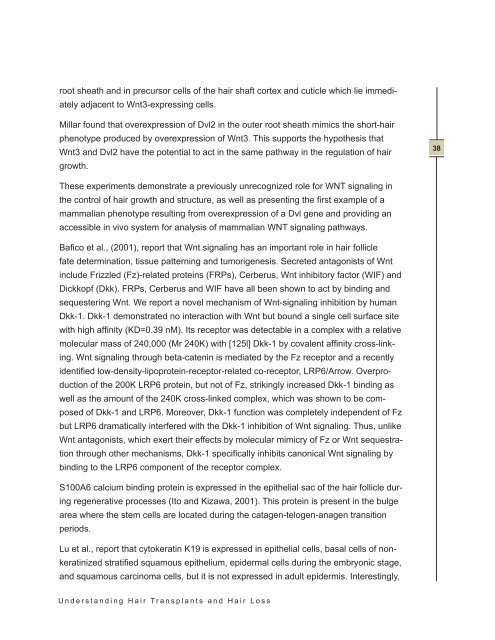Understanding Hair Transplants and Hair Loss - Pacific Hair
Understanding Hair Transplants and Hair Loss - Pacific Hair
Understanding Hair Transplants and Hair Loss - Pacific Hair
You also want an ePaper? Increase the reach of your titles
YUMPU automatically turns print PDFs into web optimized ePapers that Google loves.
oot sheath <strong>and</strong> in precursor cells of the hair shaft cortex <strong>and</strong> cuticle which lie immedi-<br />
ately adjacent to Wnt3-expressing cells.<br />
Millar found that overexpression of Dvl2 in the outer root sheath mimics the short-hair<br />
phenotype produced by overexpression of Wnt3 . This supports the hypothesis that<br />
Wnt3 <strong>and</strong> Dvl2 have the potential to act in the same pathway in the regulation of hair<br />
growth .<br />
These experiments demonstrate a previously unrecognized role for WNT signaling in<br />
the control of hair growth <strong>and</strong> structure, as well as presenting the first example of a<br />
mammalian phenotype resulting from overexpression of a Dvl gene <strong>and</strong> providing an<br />
accessible in vivo system for analysis of mammalian WNT signaling pathways .<br />
Bafico et al., (2001), report that Wnt signaling has an important role in hair follicle<br />
fate determination, tissue patterning <strong>and</strong> tumorigenesis . Secreted antagonists of Wnt<br />
include Frizzled (Fz)-related proteins (FRPs), Cerberus, Wnt inhibitory factor (WIF) <strong>and</strong><br />
Dickkopf (Dkk). FRPs, Cerberus <strong>and</strong> WIF have all been shown to act by binding <strong>and</strong><br />
sequestering Wnt . We report a novel mechanism of Wnt-signaling inhibition by human<br />
Dkk-1 . Dkk-1 demonstrated no interaction with Wnt but bound a single cell surface site<br />
with high affinity (KD=0.39 nM). Its receptor was detectable in a complex with a relative<br />
molecular mass of 240,000 (Mr 240K) with [125l] Dkk-1 by covalent affinity cross-linking<br />
. Wnt signaling through beta-catenin is mediated by the Fz receptor <strong>and</strong> a recently<br />
identified low-density-lipoprotein-receptor-related co-receptor, LRP6/Arrow. Overproduction<br />
of the 200K LRP6 protein, but not of Fz, strikingly increased Dkk-1 binding as<br />
well as the amount of the 240K cross-linked complex, which was shown to be composed<br />
of Dkk-1 <strong>and</strong> LRP6 . Moreover, Dkk-1 function was completely independent of Fz<br />
but LRP6 dramatically interfered with the Dkk-1 inhibition of Wnt signaling . Thus, unlike<br />
Wnt antagonists, which exert their effects by molecular mimicry of Fz or Wnt sequestration<br />
through other mechanisms, Dkk-1 specifically inhibits canonical Wnt signaling by<br />
binding to the LRP6 component of the receptor complex .<br />
S100A6 calcium binding protein is expressed in the epithelial sac of the hair follicle during<br />
regenerative processes (Ito <strong>and</strong> Kizawa, 2001). This protein is present in the bulge<br />
area where the stem cells are located during the catagen-telogen-anagen transition<br />
periods .<br />
Lu et al ., report that cytokeratin K19 is expressed in epithelial cells, basal cells of nonkeratinized<br />
stratified squamous epithelium, epidermal cells during the embryonic stage,<br />
<strong>and</strong> squamous carcinoma cells, but it is not expressed in adult epidermis. Interestingly,<br />
U n d e r s t a n d i n g H a i r T r a n s p l a n t s a n d H a i r L o s s<br />
38


